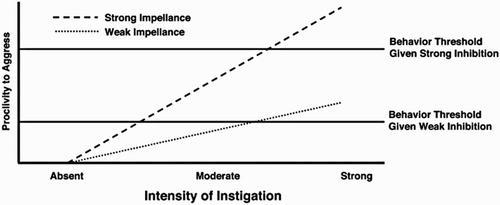Figures & data
Figure 1. I3 Model of aggression: Proclivity to aggress (y-axis) is determined by the net strength of the interaction between Instigating (x-axis) and Impellence factors. Aggressive behaviour only manifests when the strength of proclivity to aggress exceeds the strength of Inhibition factors, shown here as the behaviour thresholds. Taken from Finkel and Hall (Citation2018). Reprinted from Current Opinion in Psychology, 19, Finkel & Hall, The I3 Model: a metatheoretical framework for understanding aggression, 125-130, Copyright (2018), with permission from Elsevier.

